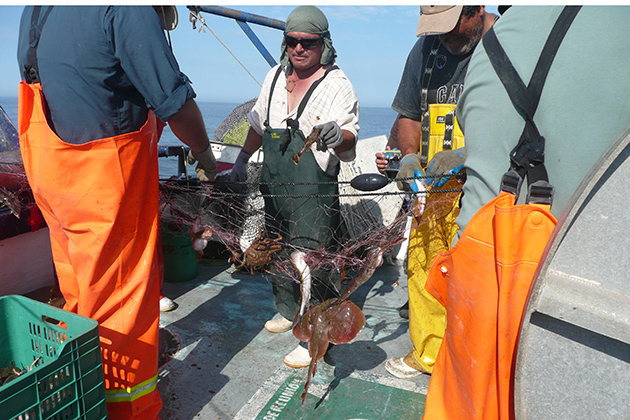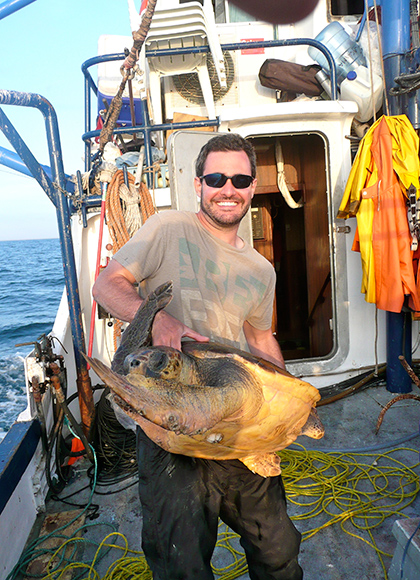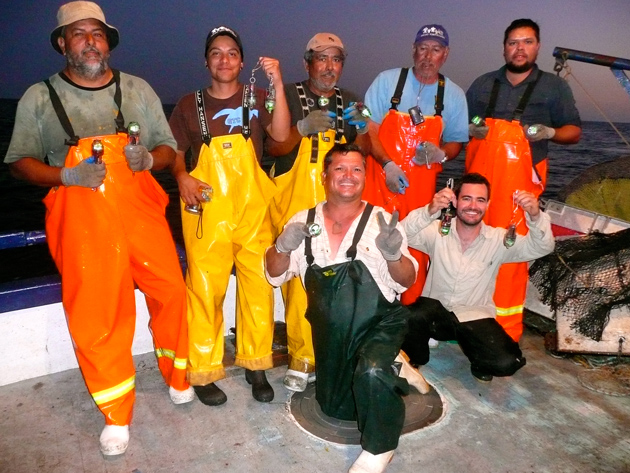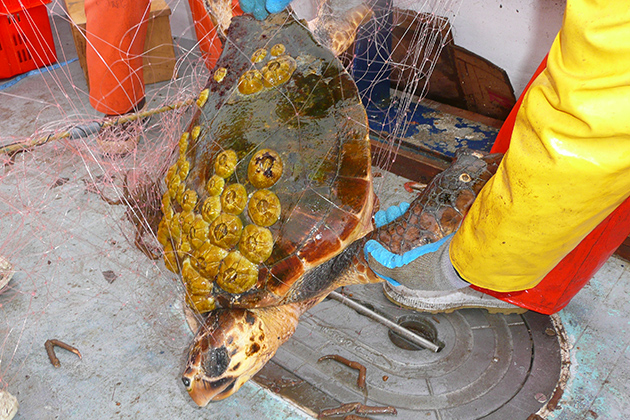
In the remote villages dotting the Pacific coast of Mexico’s Baja Peninsula, third- and fourth-generation native fishermen set out in small, 16-foot boats to spend long hours offshore. They haul kilometer-long fishing nets from the bottom of the ocean onto the decks of their vessels in hopes of eking out a meager living, earning mere cents on the dollar for catching and selling halibut in the same waters that sustained their grandfathers and great-grandfathers before them.
Halibut, however, is far from the only thing snagged by their nets. The marine life commonly tangled in their lines includes coral, sharks, squid, and endangered sea turtles, some weighing hundreds of pounds apiece. Each year, juvenile sea turtles that hatch on beaches in Japan migrate across the expanse of the Pacific Ocean to feed in Baja’s waters. Their dwindling population is concentrated in this last known hotspot, overlapping with many small-scale fisheries. In fact, along these shores, each fishing boat alone may inadvertently catch between eight and 16 sea turtles per day. While the fishermen lose time, fuel, and money repairing their nets, thousands upon thousands of these endangered marine creatures are paying with their lives every year.

“We’re finding that these small-scale fisheries that people aren’t really paying attention to are having enormous impacts on entire ecosystems,” says Jesse Senko ’06 (CANR), a UConn alum and now Ph.D. student at Arizona State University, who has dedicated his work toward resolving what may seem like an intractable situation.
Yet the novel solutions he and his colleagues have devised in recent years are, in fact, proving effective – not only in reducing the loss of marine life, but also in preserving the livelihoods of the local fishermen.
“It’s a win-win,” says Senko, who also serves as a sustainable seafood consultant for the Blue Ocean Institute. “That’s really what drives all the research I do. I think that’s where conservation biology comes up short. There is too much emphasis on how to save the animal or ecosystem, and not enough on the need to inspire people and empower them to become part of the solution.”
Beyond biology
With the guidance of his advisor, associate professor Morty Ortega, Senko first headed to Baja 10 years ago during his junior year at UConn as part of a research fellowship. Senko was on a personal mission to study sea turtles, which play a vital role in supporting marine ecosystems. “It all started with Dr. Ortega,” Senko says. “He encouraged me to study abroad in Baja and pursue research that I believed was meaningful.”
In Baja, Senko began conducting interviews with hundreds of local residents and fishermen, befriending many of them in the process and gradually becoming a trusted member of their circle.
“That’s when I became interested not just in the biology, but everything – the human dynamics really fascinated me,” says Senko, whose doctoral research is broadly focused on the impact and sustainability of small-scale fisheries. “I was learning their behavior, how they viewed the world, who the leaders were. I came back with something more valuable than research; I built relationships with people.”
These relationships, Senko acknowledges, have been crucial to his research and conservation work in the years since, as well as to his ongoing dual efforts to save sea turtles and establish sustainable fishing practices in this part of the world.
“All it takes is one or two really well-respected fishermen, and if you can get them to buy into what you’re doing and gain your trust, everyone else will eventually come along,” he says.

This past year, Senko saw this theory in action, when he and his colleagues partnered with small-scale fishing operations in one particularly successful initiative involving an unassuming battery-powered LED light.
The light, which is clipped to the fishermen’s nets, glows when immersed in water, making the nets more visible to sea turtles. Adding these lights to the nets effectively cut the percentage of nighttime sea turtle bycatch (the amount of endangered turtles unintentionally caught in the nets) by a remarkable 50 percent.
“It’s not just, ‘Do the lights reduce turtle bycatch?’” says Senko, whose work has captured the attention of such international media outlets as The New York Times. “It’s also, ‘Do they still catch fish?’ They could eliminate turtle bycatch by 100 percent, but if the fishermen are not catching what they’re out there for, they’re not going to use them. And you can’t blame them.”
Better yet, Senko found that these LED lights were resulting in increased halibut catch – an unforeseen benefit that has been well received by local fishers.
Senko is now hoping to help shift the fishermen away from gill nets altogether, and on to special traps that will catch only fish – completely eliminating turtle bycatch. With the help of his network of allies in Baja, his goal is to transition the entire fleet of these small-scale fisheries away from nets within the next three to five years.
“The great thing about traps is that the fish will be alive and thus in better condition, so fishers can make more money and release the smaller fish alive, all while eliminating turtle bycatch. Everyone wins,” Senko says.
Living dinosaurs
Senko admits that even with the headway he and his colleagues have made thus far, the work itself takes an enormous emotional toll. Conducting research alongside fishermen, he frequently witnesses the harm caused every day to sea turtles entangled underwater in gill nets.

“The turtles come up gasping for air. They’ll literally throw up a bucketful of water,” he says. “We’ve had turtles on the boat for 12 hours, trying to drain all the water out of their lungs. After 12 hours, they’re still gasping. It’s heartbreaking to watch.”
As grim as this can often be, Senko says it keeps him committed. “For me, it’s important to be emotional about it, because that’s what drives me. If I could look at a dying turtle, see it throwing up water and blood and be nonchalant about it, then I shouldn’t be doing this,” he says. “What keeps me staying positive is focusing on the solutions. You can’t lose sight of the goal.”
For Senko, sea turtles offer something beyond even their influential role in the ecosystem. “It’s corny, but there’s something magical about looking into the eyes of a sea turtle,” he says. “They’ve been around for 200 million years. They’re literally living dinosaurs. When you look into their eyes, you can’t describe it with words. Something neurological is going on in your brain. You’re making this connection. So that’s what I tell people – if you ever get to see a live sea turtle, in an aquarium, in the wild, it doesn’t matter, stare into its eyes for five minutes. It just might change your life.”
Watch the documentary featuring UConn alum Jesse Senko’s work, “Meshing Conservation and Culture in Magdalena Bay,” as covered in The New York Times. Follow Senko on Twitter at @jesseSenko.



